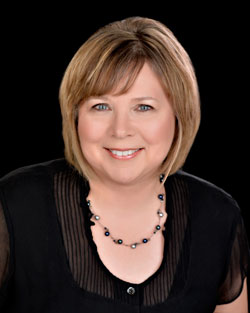Research Awards
Dr. Barbara Vanderhyden
Cancer Therapeutics Program / Programme de thérapeutique anticancéreuse
Winner of the Dr. J. David Grimes Research Career Achievement Award 2014 Lauréat du Prix Dr J. Grimes du merité scientifique

A photograph of the late Corinne Boyer greets elevator riders on the third floor of the Centre for Innovative Cancer Research (CICR) at the Ottawa Hospital Research Institute.
Some riders are visitors, and their glances offer a passing tribute to the two-time cancer survivor who fought for women's health research funding before succumbing to ovarian cancer in 1995. Others are staff and know intimately of her legacy.
But for Dr. Barbara Vanderhyden, a 23-year veteran at the hospital who has spent 14 years as the Corinne Boyer Chair in Ovarian Cancer Research, the elevator lobby image resonates tremendously. It's matched by another portrait resting beside her computer screen – a personalized framed picture of Boyer given to her by Boyer's husband.
"Corinne was a born leader; I certainly am not. But I have done everything I can to build a research community in Canada that reflects the needs that were not met when Corinne was alive," says Dr. Vanderhyden, senior scientist in OHRI's Cancer Therapeutics Program and professor of cellular and molecular medicine at the University of Ottawa.
Dr. Vanderhyden is modest. She is, in fact, an internationally recognized ovarian biologist. She joined a fledgling group of cancer researchers at the university in 1991. Four years later, the building that now houses The Ottawa Hospital Cancer Centre was constructed and she was named its endowed chair in 2000.
As founder and initial chair of the Canadian Conference on Ovarian Cancer Research (CCOCR), Dr. Vanderhyden continually seeks to maximize "team dynamics" in the field. Since 2002, the conference has been, with the similarly named COCRC (Canadian Ovarian Cancer Research Consortium), connecting research groups across the country through regular meetings that forge alliances and lead to breakthroughs.
A year after organizing the first conference, she made one such breakthrough. She published the first model system using transgenic mice to study new treatments of ovarian cancer. Aided by sparks of collaboration resulting from COCRC, the model developed and overcame a major hurdle known to oncologists worldwide.
Dr. Vanderhyden speaks excitedly about researchers collaborating. And she is keen about her work developing a new generation of scientists.
"The research always comes first. It has to. That's my job and that's where I need to have the greatest impact. Anything I can do on the side," she says, "is gravy."
The gravy – groundwork outside of lab and clinic – has hardly been negligible. At a time when zero teaching assistant experience was offered to graduate students who came to work with her, she developed formal ways to prepare and give them confidence.
Starting in 1993, her mentoring and outreach programs motivated young people to explore the scientific world and to foster learning exchanges in communities where there were previously little engagement. "Let's Talk Science-Parlons sciences" – now a national charitable organization – and "Science Travels-La science voyage" are built on her passion for science education.
More than two decades later, Dr. Vanderhyden continues to nurture these programs, adding mentorship opportunities in 2006. Program teachers – scientists-in-training – increase science literacy in Aboriginal communities and among elementary and high-school students while they acquire the skills to speak publicly about their research.
Given the amount of time and effort she devotes beyond her scientific research, it's no wonder peers see Dr. Vanderhyden as an ambassador.
Even the Governor General has noticed. In April 2014, she received the Caring Canadian Award for dedicated volunteerism including volunteer leadership positions she holds with Ovarian Cancer Canada that include raising awareness by meeting with women who are struggling with their diagnosis of ovarian cancer.
"What we do is not separate from the patients, what we do is for the patients," says Dr. Vanderhyden, noting that testing new treatments is paramount in ovarian cancer.
Her most recent publication describes a new model of high-grade serous cancer, the most common and deadly type of ovarian cancer.
"If even one woman is cured of her cancer because of a new treatment that we discover, then it's all worth it."
